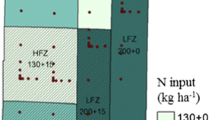Abstract
Historic results of perennial ryegrass (Lolium perenne L.) breeding include improved disease resistance, biomass, and nutritional quality. Yet, lack of tolerance to water stress limits its wide use. Recent efforts to increase water soluble carbohydrate (WSC) content in perennial ryegrass may increase drought tolerance. Herein, we report results of a multi-year and location evaluation of differing precipitation/irrigations levels on genetic and genotype × environment interaction effects of various agronomic traits in perennial ryegrass. The study included two UK environments (Aberystwyth, Wales and Edinburgh, Scotland) and four USA environments located in Logan, UT and consisting in four supplemental irrigation levels in a line-source irrigation design. Data included herbage dry matter, dry matter digestibility, crude protein, and WSC, collected from 2011 to 2013. There were differences (P < 0.05) among the included cultivars for each phenotype when evaluated across environments. There was observed cultivar × environment interaction for each phenotype, which precluded the identification of the best cultivar over all environments. Additive main effect and multiplicative interaction modeling allowed for grouping of the individual environments to mega-environments. The analysis identified three mega-environments for each phenotype: (1) the UK environments, (2) the two highest Logan irrigation levels, and (3) the two lowest Logan irrigation levels. Mega-environments designations corresponded to water stress, temperature, and inherent geographic/climate differences between the environments. The evidence for the potential of increased WSC to improve drought tolerance under water stress was inconclusive, but high WSC cultivars also exhibited high herbage production under the imposed water stress.


Similar content being viewed by others
References
Amiard V, Morvan-Bertand A, Billard J-P, Huault C, Keller F, Prud’homme M-P (2003) Fructans, but not the sucrosyl-galactosides, raffinose and loliose, are affected by drought stress in perennial ryegrass. Plant Physiol 132:2218–2229
Bates D, Maechler M, Bolker B, Walker S (2014). lme4: linear mixed-effects models using eigen and S4. R package version 1.1-7. http://CRAN.R-project.org/package=lme4
Casler MD (1995) Patterns of variation in a collection of perennial ryegrass accessions. Crop Sci 35:1169–1177
Edwards GR, Parsons AJ, Rasmussen S, Bryant RH (2007) High sugar ryegrasses for livestock systems in New Zealand. Proc N Z Grassl Assoc 69:161–171
Escribano S, Robins JG (2014) Phenotypic performance of timothy accessions under irrigated and nonirrigated conditions. Crop Sci 54:1079–1086
Frame J (1991) Herbage production and quality of a range of secondary grass species at five rates of fertiliser nitrogen application. Grass Forage Sci 46:139–151
Gauch HG (1993) Prediction, parsimony, and noise. Am Sci 81:468–478
Gauch HG (2007) MATMODEL Version 3.0: open source software for AMMI and related analyses. Crop and Soil Sciences, Cornell University, Ithaca, NY 14853
Hume DE, Hickey MJ, Lyons TB, Baird DB (2010) Agronomic performance and water-soluble carbohydrate expression of selected ryegrasses at two locations in New Zealand. N Z J Agri Res 53:37–57
Humphreys MO (1989a) Water-soluble carbohydrates in perennial ryegrass breeding. I. Genetic differences among cultivars and hybrid progeny grown as spaced plants. Grass Forage Sci 44:231–236
Humphreys MO (1989b) Water-soluble carbohydrates in perennial ryegrass breeding. II. Cultivars and hybrid progeny performance in cut plots. Grass Forage Sci 44:237–244
Humphreys MO (1989c) Water-soluble carbohydrates in perennial ryegrass breeding. III. Relationships with herbage production, digestibility and crude protein content. Grass Forage Sci 44:423–429
Humphreys M, Feuerstein U, Vandewalle M, Baert J (2010) Ryegrasses. In: Boller B, Posselt UK, Veronesi F (eds) Handbook of plant breeding: fodder crops and amenity grasses, vol 5. Springer, New York, pp 211–260
Jensen KB, Asay KH, Waldron BL (2001) Dry matter production of orchardgrass and perennial ryegrass at five irrigation levels. Crop Sci 41:479–487
Jensen KB, Waldron BL, Asay KH, Johnson DA, Monaco TA (2003) Forage nutritional characteristics of orchardgrass and perennial ryegrass at five irrigation levels. Agron J 95:668–675
Jung GA, Van Wijk AJP, Hunt WF, Watson CE (1996) Ryegrasses. In: Moser LE, Buxton DR, Casler MD (eds). Cool-season forage grasses. Agronomy No. 34. ASA-CSSA-SSSA, Madison, pp 605–641.
Miller LA, Moorby JM, Davies DR, Humphreys MO, Scollan ND, MacRae JC, Theodorou MK (2001) Increased concentration of water-soluble carbohydrate in perennial ryegrass (Lolium perenne L.): milk production from late-lactation dairy cows. Grass Forage Sci 56:383–394
Parsons AJ, Rasmussen S, Xue H, Newman JA, Anderson CB, Cosgrove GP (2004) Some ‘high sugar grasses’ don’t like it hot. Proc N Z Grassl Assoc 66:265–271
R Core Team (2014). R: a language and environment for statistical computing. R Foundation for Statistical Computing, Vienna, Austria. http://www.R-project.org/
Robins JG, Jensen KB (2011) Identification of creeping foxtail germplasm with high dry matter yield and nutritive value. Crop Sci 51:728–735
Sanada Y, Takai T, Yamada T (2007) Ecotypic variation of water-soluble carbohydrate concentration and winter hardiness in cocksfoot (Dactylis glomerata L.). Euphytica 153:267–280
Smeal D, O’Neill MK, Arnold RN (2005) Forage production of cool season pasture grasses as related to irrigation. Agric Water Manag 76:224–236
Tallowin JRB, Brookman SKE, Santos GL (1995) Leaf growth and utilization in four grass species under steady state continuous grazing. J Agric Sci 124:403–417
Volaire F, Lelièvre F (1997) Production, persistence, and water-soluble carbohydrate accumulation in 21 contrasting populations of Dactylis glomerata L. subjected to severe drought in the south of France. Crop Pasture Sci 48:933–944
White SR, Carlyle CN, Fraser LH, Cahill JF (2012) Climate change experiments in temperate grasslands: synthesis and future directions. Biol Lett 8:484–487
Wilkins PW (1991) Breeding perennial ryegrass for agriculture. Euphytica 52:210–214
Wilkins PW, Humphreys MO (2003) Progress in breeding perennial forage grasses for temperate agriculture. J Agric Sci 140:129–150
Wilkins PW, Lovatt JA (2004) Recent gains from forage grass breeding. IGER Innov 9:18–21
Wilkins PW, Lovatt JA (2011) Gains in dry matter yield and herbage quality from breeding perennial ryegrass. Ir J Agric Food Res 50:23–30
Zobel RW, Wright MJ, Gauch HG Jr (1988) Statistical analysis of a yield trial. Agron J 80:388–393
Author information
Authors and Affiliations
Corresponding author
Rights and permissions
About this article
Cite this article
Robins, J.G., Alan Lovatt, J. Cultivar by environment effects of perennial ryegrass cultivars selected for high water soluble carbohydrates managed under differing precipitation levels. Euphytica 208, 571–581 (2016). https://doi.org/10.1007/s10681-015-1607-9
Received:
Accepted:
Published:
Issue Date:
DOI: https://doi.org/10.1007/s10681-015-1607-9




